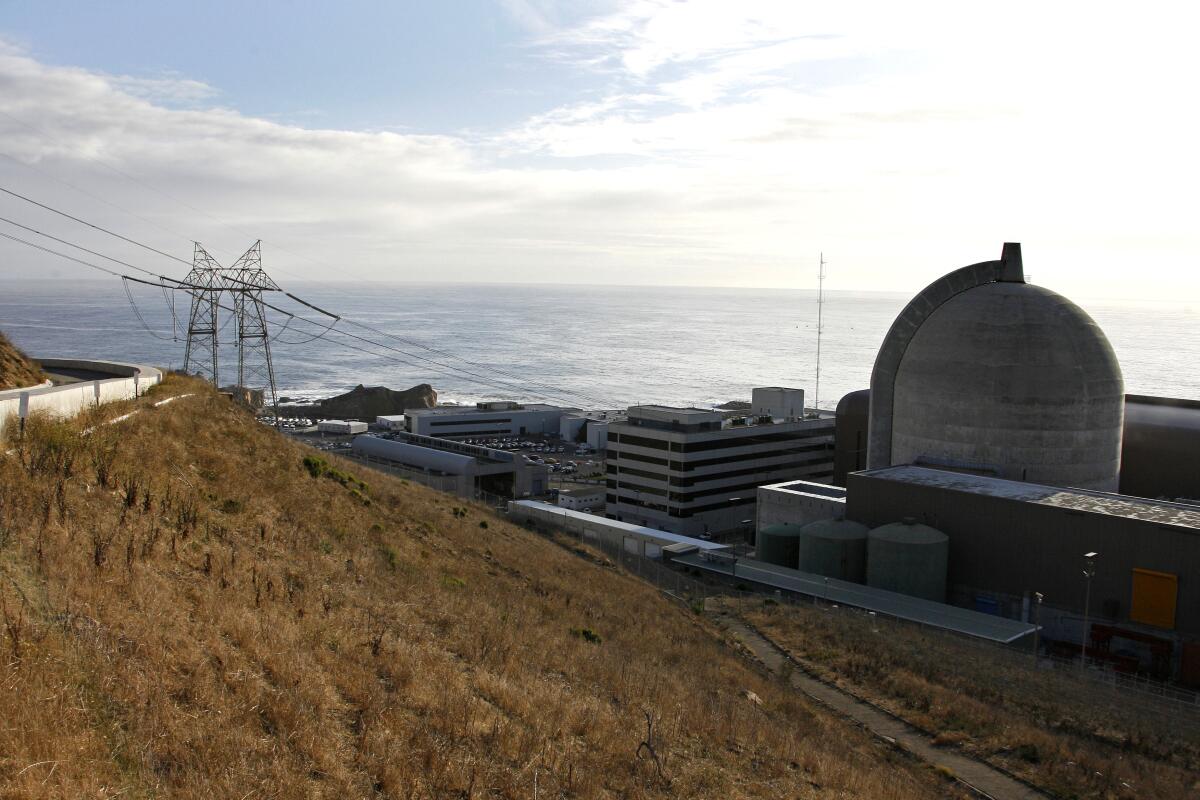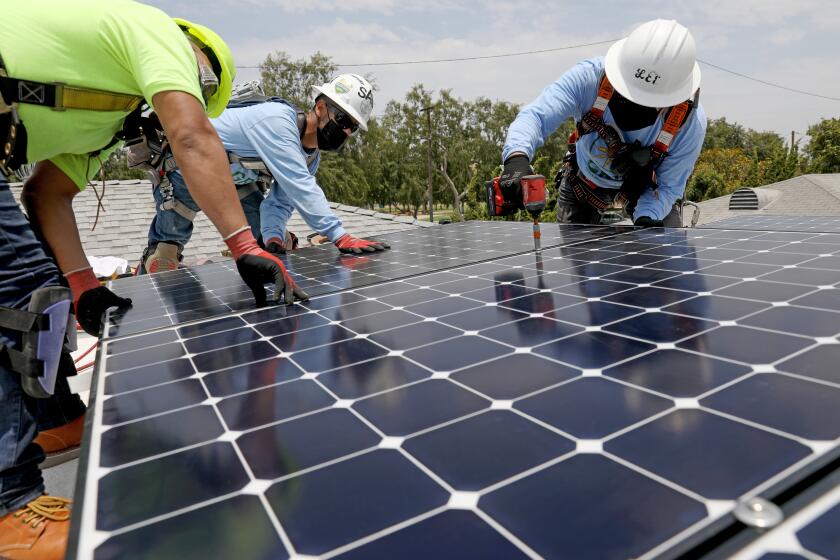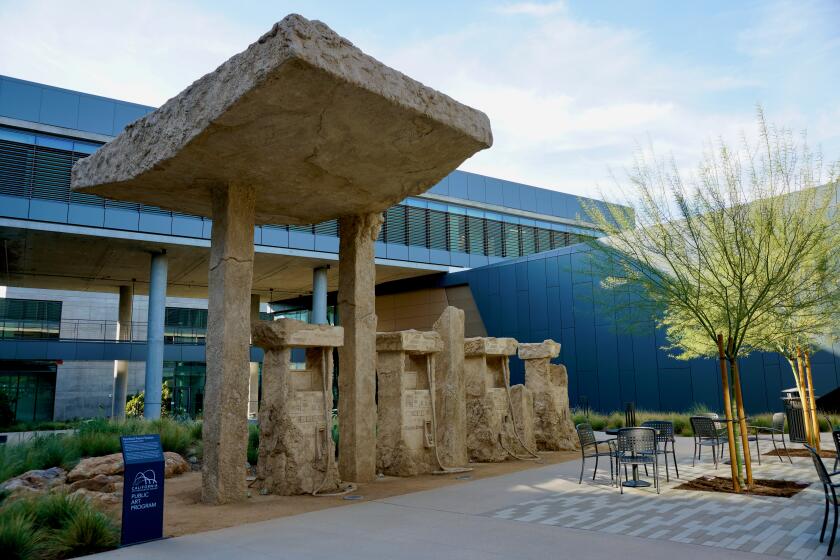Editorial: No, California shouldn’t extend the life of its last nuclear plant. There are better ways to fight climate change

- Share via
California is approaching an energy crossroads. In three years, its last nuclear plant will begin to power down and the state will lose its largest single source of emissions-free electricity.
A 2018 law requires state regulators to “avoid any increase in greenhouse gases” as a result of closing the Diablo Canyon nuclear power plant on the Central Coast. But if they don’t move more quickly to replace its electricity with renewable energy from wind, solar and geothermal, the void will almost certainly be filled by burning more natural gas, which increased last year to account for nearly half of California’s in-state electricity generation.
California can’t allow the retirement of Diablo Canyon’s nuclear reactors to prolong its reliance on gas plants or increase planet-warming and health-damaging emissions. But the state’s preparations for shutdown of an around-the-clock power source that supplies more than 8% of California’s in-state electricity generation have not inspired confidence; there have been no assurances that an uptick in carbon emissions will be avoided.
Gov. Gavin Newsom’s administration is preparing to make it harder for Californians to go solar. That’s OK, but regulators would be unwise to gut one of the state’s most popular and successful renewable energy programs.
That uncertainty has created an opening for a new push to extend Diablo Canyon’s life. A recently launched campaign, whose supporters include former U.S. Energy secretaries Steven Chu and Ernest Moniz, and fashion model and nuclear influencer Isabelle Boemeke, wants California to abruptly reverse course and keep Diablo Canyon operating for another 10 or even 20 years.
Proponents say this would reduce climate pollution, bolster grid reliability and buy time during a crucial period in the state’s transition toward solar, wind and other renewable energy sources, citing a recent report by Stanford University and MIT scientists that lends support to the idea. The Biden administration has chimed in receptively, with Energy Secretary Jennifer M. Granholm suggesting in a recent interview that California might reconsider closing the facility to avoid losing an always-on source of clean electricity.
But the idea is misguided, and at this point remains largely divorced from reality. The plant’s closure should instead serve as an impetus for California do more to accelerate the shift to renewable energy and set a realistic course to meet the state’s target of getting 100% of its electricity from carbon-free sources by 2045.
Those floating the idea of keeping Diablo Canyon open seem to ignore many practical considerations, including how to address seismic risks, the ecological harm of using seawater for cooling, and what to do with spent nuclear fuel. The cooling system and earthquake safety upgrades that would be required for the facility to keep operating after 2025 are so extensive they would likely exceed $1 billion, according to the Public Utilities Commission.
The sculpture of a fossilized gas station at California’s new emissions testing lab in smoggy Riverside? The symbolism is perfect.
The plant’s operator, Pacific Gas and Electric Co., agreed in 2016 not to pursue license renewal, in part because closing the plant and replacing it with other zero-carbon energy sources and storage would cost less than keeping it open. The utility has shown no interest in reconsidering, nor has the Public Utilities Commission received any proposals to revisit its 2018 decision to allow the plant to shut down.
Still, the pro-nuclear camp is right in pointing out that the urgency of fighting global warming has only increased in the five years since the decision to close Diablo Canyon. Wildfires and other climate impacts are worsening at an alarming clip. Last year, California experienced its first rolling blackouts in nearly two decades thanks to climate-fueled heat waves that forced the state to burn more planet-warming gas to keep the power on. And the recent global climate summit in Glasgow, Scotland, showed that world leaders aren’t yet acting with the urgency needed to avert catastrophic warming.
But there are good reasons to eschew nuclear power as a solution. The world is still dealing with repercussions from the Chernobyl and Fukushima nuclear disasters, which rendered huge zones uninhabitable and spread radioactive isotopes across the globe; and closer to home, the cleanup of the 1959 partial nuclear meltdown at the Santa Susana Field Laboratory near Simi Valley. Because the United States has no designated repository for high-level radioactive waste, spent nuclear fuel is stored on site at power plants across the country, posing ongoing risks. We can and should curb the dangers of fossil fuel combustion and nuclear fission at the same time, not use the threat of one to prop up the other.
Replacing Diablo Canyon responsibly will require faster deployment of wind and solar farms and rooftop panels as well as batteries to store energy for use when the sun isn’t shining or the wind isn’t blowing. Upgrades to transmission lines are also needed to make more carbon-free energy available.
The Public Utilities Commission took an important step in June, when it approved an order requiring utility companies to bring online a massive amount of new clean electricity resources by 2026 to help fuel demand during extreme heat events and replace generation from old, retiring gas plants and Diablo Canyon. But environmental advocates say the state’s plan moves too slowly and leaves the door open to a rise in fossil fuels to create electricity. That’s what happened in 2012, when California’s greenhouse gas emissions rose by 2%, in part because of increased used of gas plants following the unanticipated closure of the malfunctioning San Onofre nuclear power plant.
This time, regulators have had years to prepare for Diablo’s retirement and should not leave things to chance. Gov. Gavin Newsom and the incoming PUC president he recently named, Alice Reynolds, need to do more to get renewable energy sources operating as quickly as possible, and should carefully track them and impose requirements that they reduce climate pollution. It’s our planet at stake, and California’s leaders must ensure the sunset of nuclear power is not followed by a damaging rise in greenhouse gases.
More to Read
A cure for the common opinion
Get thought-provoking perspectives with our weekly newsletter.
You may occasionally receive promotional content from the Los Angeles Times.












